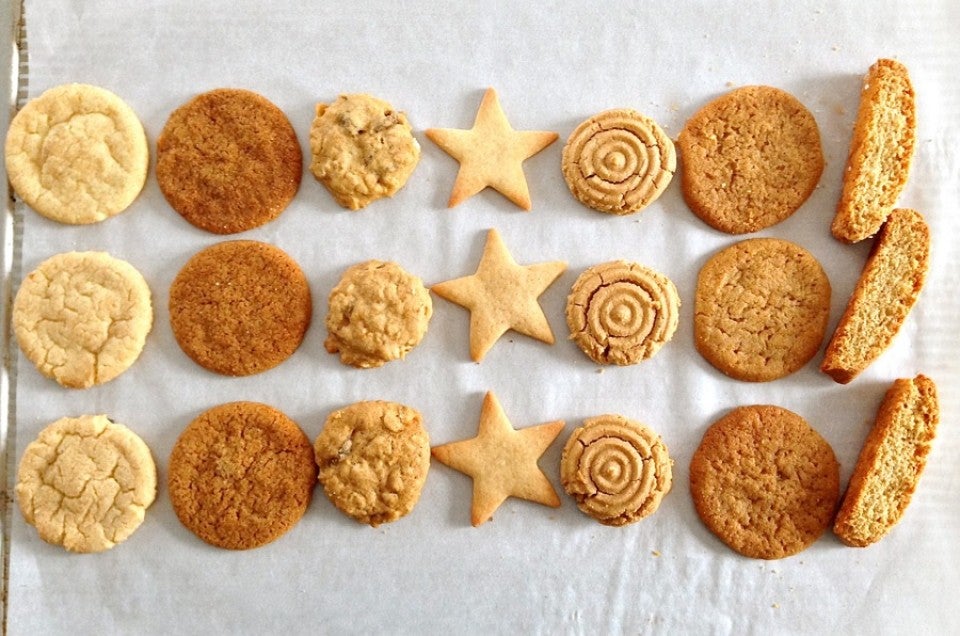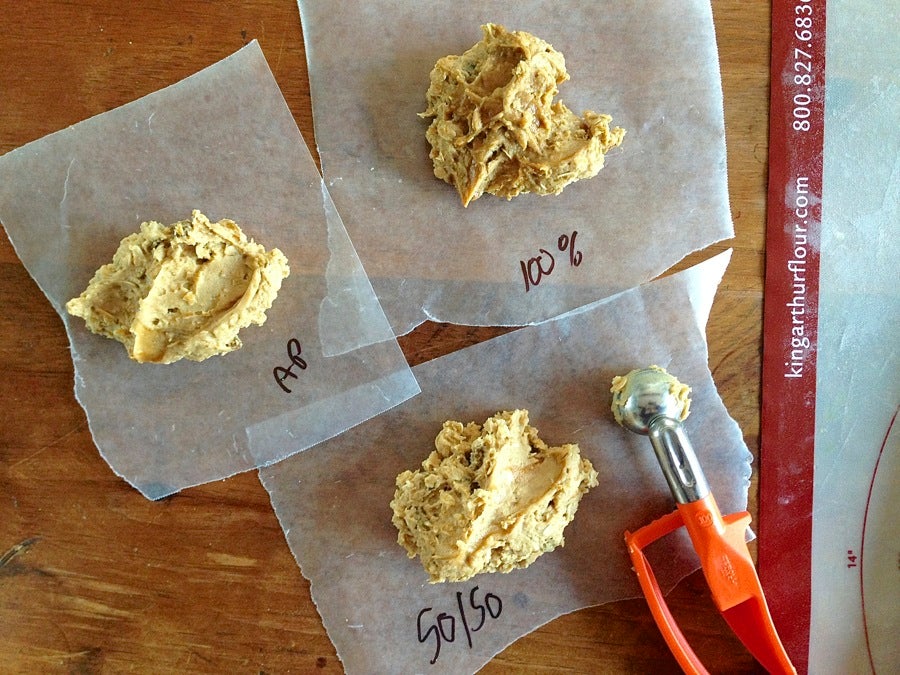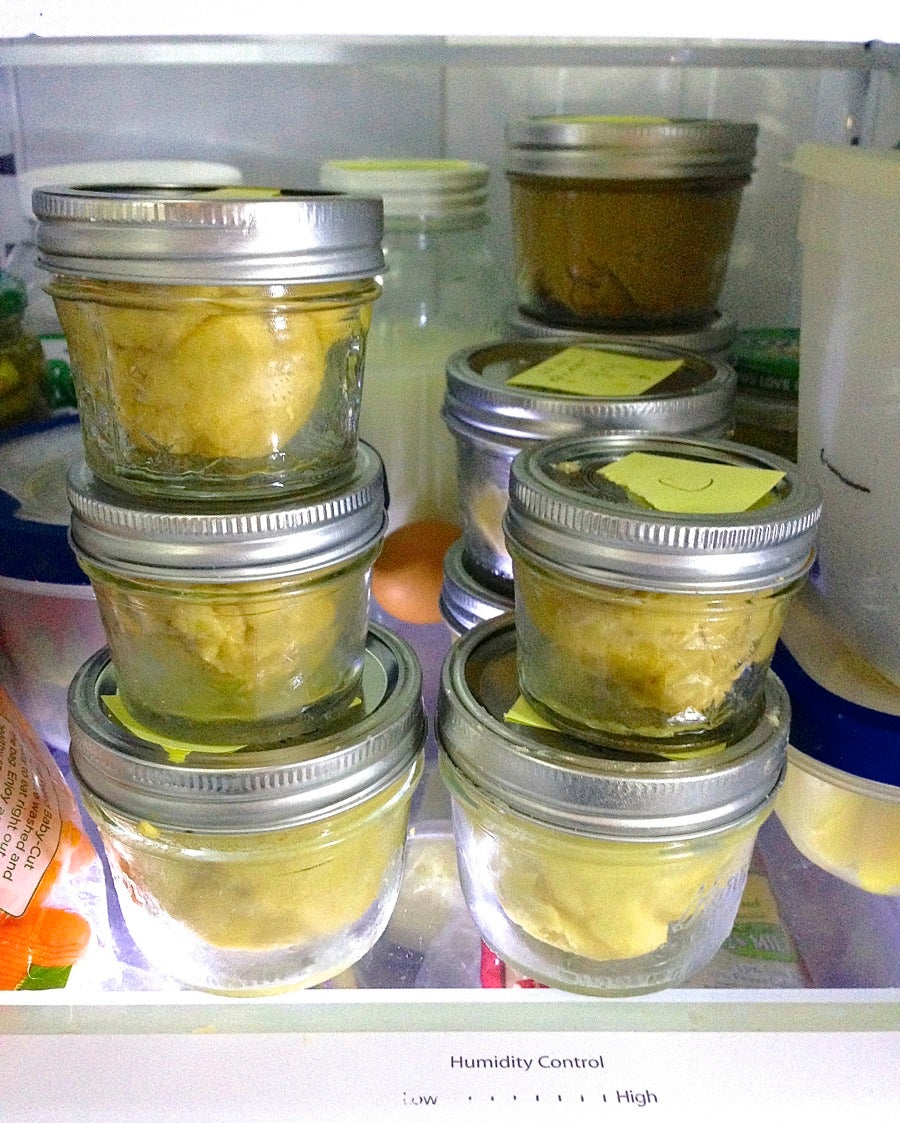


Have you ever hesitated over your mixing bowl, looking at the butter and sugar and eggs, and musing, "Hmmm, I wonder if I can sneak some whole wheat into these chocolate chip cookies?"
This vexing question usually gives way to caution, habit, and all-purpose flour – and once again, you've lost the opportunity to do the test:
Will the family notice if I add whole wheat to these cookies... or not?
The cookies on the right are made with King Arthur Unbleached All-Purpose Flour; in the center, with our 100% golden wheat flour (formerly called "white whole wheat flour," which you'll see reflected throughout this piece!); and on the left, our 100% traditional (red) whole wheat flour.
Would your family be able to tell the difference?
Yes, probably, if you use red whole wheat flour. Probably not if you use golden wheat flour.
And certainly not, if you use a 50/50 blend of golden wheat and all-purpose flours.
Does this rule of thumb hold fast across all different cookie genres, from the most delicate vanilla cutouts to hearty, chewy oatmeal cookies?
And what about brownies and bars?
Let's find out.
Here are our two whole wheat flours: golden wheat flour, and (red) whole wheat flour.
Let me modify that: our two 100% whole wheat flours.
There's a lot of confusion around golden whole wheat flour (formerly called "white whole wheat flour"). If it's really whole wheat, how come it's called "golden"? Is it bleached, for lighter color? Is it a blend? Is it really 100% whole wheat?
1) It's called golden wheat flour because it's milled from white whole wheat berries, which are lighter. Wheat berries, like roses, come in more than one color. Unlike roses, though, they're limited to just two colors: red, and white. Are red roses and pink roses both roses? Yes. Are red whole wheat flour and goldenwheat flour both whole wheat flours? Yes.
2) Golden wheat flour isn't bleached.
3) Golden wheat flour isn't a blend; it's 100% whole wheat – "nothing added, nothing taken away."
4) Yes, honest, we wouldn't fool you – golden wheat flour is really 100% whole wheat.
Now, back to our cookies. I decided to test cookie recipes calling for all-purpose flour three ways: using 100% all-purpose flour; 50% golden wheat/50% all-purpose; and 100% golden wheat.
So, how come I'm not testing cookies with RED whole wheat flour?
Because I tried that initially, with 40 fellow King Arthur Flour employee-owners as a test group for those chocolate chip cookies pictured at the top of this post.
And the cookies made with red whole wheat flour, while acceptable to most, earned a negative reaction from some. "Funny texture," was the consensus. Since red whole wheat is darker and stronger-flavored than golden wheat, and its slightly coarser grind can change cookies' texture, I decided to relegate it to the sidelines.
If you like the flavor and "bristly bran" texture of traditional whole wheat flour, feel free to use it in cookies. But if you're trying to "get away with" using whole wheat flour, golden wheat is your best choice.
As for recipes, I chose the eight types of cookies featured in our King Arthur Flour Cookie Companion cookbook. Labeled "essential," these are the broad varieties of cookies we Americans make the most.
Let's jump right in by making an old-fashioned, all-time favorite, the #2 cookie (after chocolate chip) in our "What's your favorite cookie?" Facebook poll.
Considering how "blonde" these are, I figure they'll be a good test: will anyone notice the color difference?
I make three batches of dough: 100% all-purpose flour; 50% golden wheat/50% all-purpose; and 100% golden wheat.
Mix, roll into balls, shake in cinnamon-sugar, flatten...
...bake.
Side by side, yes, you can see a slight color difference between the white (all-purpose) flour cookies, and the whole wheat cookies. But it's subtle; you really need all three types, side by side, to see the color gradation from light to darker gold.
And texture? The mouth feel of the 100% whole wheat cookies is very slightly more "grainy" than that of either the 50/50 or AP cookies.
Let's try that again, this time making everyone's holiday favorite: cutout sugar cookies.
I don't want to use only King Arthur Flour recipes; this guide is designed to test whether you can substitute whole wheat flour in ANY recipe: from your favorite cookbook, a trusted online source, or your grandma's recipe box.
Anyone familiar with Cook's Illustrated magazine knows they're a quality outfit, with good recipes. Let's try one of their recipes.
You can certainly see a difference in the dough, before the cookies are baked; the 100% golden cookies are darker in color.
But once baked? The picture at lower right in the block above shows how, with baking, the color difference fades. Left to right, there's a vertical column of all-purpose flour cookies, 50/50, and 100% golden wheat.
Again, the 100% whole wheat are slightly darker; but without another cookie alongside for comparison, would you be able to tell? Probably not.
Texturally, though, the 100% golden wheat cookies display some definite "grit." They're so crisp and dry, and so plain (no oats, no chips, etc.), that you can definitely "feel" the bran in your mouth. Icing them would probably help, but hey, why not just go with the 50/50 blend here?
After all, you'll be benefiting from the nourishing vitamins and minerals found in enriched all-purpose flour, and the fiber plus additional vitamins and minerals in whole wheat flour. The two flours complement one another wonderfully well – not just in flavor and performance, but in dietary benefits.
These are the scraps from my roll-outs, all mixed up. When cutting out rolled cookies, I very seldom bother to "gather and re-roll the scraps." I mean, why bother? All it does is make tough "pretty" cookies.
I'd rather enjoy tender/crisp "scrap" cookies. Just consider them my salute to modern art.
Next up, the very plainest cookie of all – and thus a great test for substituting golden wheat for white flour.
Shortbread. Butter, sugar, flour, and salt; that's all she wrote.
In this case, thick, crumbly, oat-enhanced Classic Scottish Shortbread.
Different shades of dough; different shades of shortbread. But all tasty; all good. Again, the potential grainy mouth-feel from the bran is overshadowed by the crunchiness of the oats.
Let's move on to another classic: oatmeal cookies.
And who better to provide us with our oatmeal cookie recipe than Margaret Rudkin, the original proprietress of Pepperidge Farm? Her 1963 cookbook includes recipes for dishes as disparate as white wine jelly and crab mousse; though Milano cookies are nowhere to be found!

Since the cookie dough includes oats, molasses, cinnamon, and raisins, it's harder to see a color difference.
And, once baked, it's virtually impossible to see any difference between the white flour and 50/50 cookies; the 100% golden wheat cookies are a shade darker.
And flavor-wise? No difference.
How about texture? Well, with the aforementioned oats plus raisins, it's hard to detect any textural difference, either.
Sad to say, the recipe itself isn't a winner; I find the cookies bland and boring. Thankfully, Pepperidge Farm has come a long way with its cookies since these. Bring on the Tahoe Chocolate Chunk Chocolate Macadamia Cookies!
Molasses cookies are another traditional American favorite...
...and nowhere are they as beloved as in Maine, where you'll find one iteration after another, from soft, cake-like tidbits to crunchy disks big around as your hand.
Rolling the dough balls in sugar gives these thin molasses cookies extra crunch.
I don't notice any difference in the dough, save slightly different color. Ditto the cookies; their crispness, plus the crunchiness of the sugar, overwhelms any possible graininess from the bran, texture-wise, in the 100% whole wheat cookies.
The verdict? I'll gladly consume any of these.
Despite the growing preponderance of food allergies, peanut butter cookies are still beloved by many. My favorite PB cookie recipe comes from our Cookie Companion. It's also in our online recipe archive.
Hey, what's up with the circles, instead of the traditional fork criss-cross?
I like to change things up every now and then by flattening cookie dough using the end of the pusher from my Cuisinart food processor.
No difference, right?
Well, hold on; in the process of scooping and flattening dough, one of my baking sheets sits around for about 25 minutes before going into the oven. And the 100% golden cookies from that particular baking sheet don't spread quite as much; they're slightly taller, slightly smaller diameter.
What's up with that?
Golden flour, due to its coarser grind, takes longer to absorb any liquid in a recipe. Which means, when your dough is stiff to begin with – as this peanut butter cookie dough is – if you don't bake the cookies right away, the whole wheat will absorb their liquid, making them spread less.
Hmmm... Should I consider adding extra liquid to cookies made with 100% golden wheat flour?
I give it a try with chocolate chip cookies, just to see what will happen. And I don't wait for the wheat to absorb the water; I want to see what will happen when I bake the cookies right away.
The result? It's a bit difficult to tell from this picture, but the cookies with added water spread more than those without. Which makes total sense; the higher the liquid/flour ratio in a cookie, the more it'll spread as it bakes.
So, given some recipes call for cookie dough to wait awhile before being baked (most often in the fridge), is it necessary to add extra water to 100% golden wheat cookies, in order for them to match the spread of cookies made with all-purpose flour?
Let's find out.
I decide to make my favorite Chocolate Chip Cookies, the ones I bring to every occasion requiring them: i.e., anytime kids are in the audience. For this experiment, though, I leave out the chips – they interfere with how the cookies spread.
Going on the premise that yes, cookies that'll wait at least 25 minutes before hitting the oven will need extra liquid, I perform the following experiment:
Five batches of cookie dough: 100% all-purpose flour; 50/50; and three 100% golden wheat flour doughs, using increasing amounts of liquid – in this case, orange juice.
Why OJ? While it doesn't lend any flavor of its own, orange juice (used in small amounts) seems to temper the sometimes assertive flavor of whole wheat.

I divvy up each of the five doughs into four batches. Yes, things are starting to get complicated!
The first batch I bake immediately; the remaining batches go into the fridge.
Later, I come back and bake cookies after the dough has rested for 4 hours, 24 hours, and 48 hours, all in the fridge. I want to see if the varying amounts of OJ will create different amounts of spread after successively long chill times.
And the envelope, please:
The 100% all-purpose flour cookies (B); and the 100% golden wheat cookies with added liquid (1, 2, and 3) spread the same amount, from 4 hours right through 48 hours. The 50/50 cookies (A) spread a bit less.
Here's a closer look. See how the 50/50 cookies stand a bit taller, spread a bit less? Apparently using even half golden wheat flour requires adding a bit of liquid, if you're going to let the dough chill (or rest) longer than 25 minutes or so.
I'm surprised that the cookies baked after 48 hours spread the same as those baked after 4 hours; I would have assumed the older dough would have been drier, and the cookies would have spread less.
You can't argue with your results, though, right? Admittedly this is very casual science here; done in a more serious environment, perhaps the 48-hour dough WOULD have spread less. But we're home bakers, not working under controlled conditions in the Keebler test kitchen. It's good news that you can stash your cookie dough for a couple of days without affecting your cookies' ultimate texture.
Next, let's try a very soft cookie dough that yields a very hard cookie –
Biscotti. Specifically, American-Style Vanilla Biscotti.
What makes this biscotti "American-style"?
While Italian biscotti are rock-hard, perfect for softening in a glass of wine or cup of coffee, American biscotti are crunchier and lighter; they can be enjoyed as is, without dunking.
When I stir up the biscotti dough, I notice the 100% golden wheat dough is noticeably stiffer than the 100% all-purpose flour dough. I wonder if I should add some liquid to the whole wheat dough...
Nah. Let's see what happens just doing a straight golden wheat substitute, without tweaks.
In fact, the golden wheat biscotti log doesn't rise quite as exuberantly as the one made with all-purpose flour. Next time, I'll add additional liquid (orange juice) to the golden wheat dough.
Still, the resulting biscotti are delicious, no matter what their percentage of golden wheat flour. Slightly darker, slightly smaller, the whole wheat biscotti don't reveal any bran in their mouth-feel; the crunchiness of the cookie negates the bran's grit.
Let's move on to bars, shall we?
I've been looking for a good pumpkin bar recipe forever. What I'm after is something with fudge brownie texture, and pumpkin flavor.
Does the Pumpkin Bar recipe in this 1981 book from the State Historical Society of Wisconsin fill the bill?
No. Dry and cakey, these pumpkin "bars" might as well have been muffins – and not very good muffins, either. Darn: and I'm a Wisconsin gal!
Still, the test was "Does using golden wheat flour in this white flour recipe make a difference?"
Slight color difference, but beyond that – not that I can tell. Especially once the bars sit overnight, the bran softens, its grainy texture disappearing.
And if you want a colorful bar – well, you've found it!
Last, and most certainly not least, let's try brownies.
This picture doesn't begin to do justice to my favorite brownie recipe. Studded with chocolate chips, sporting a thin, shiny crust that disintegrates into a shower of shards at first bite, these are the brownies to take along on your trip to a desert (dessert?) island.
Does golden wheat flour diminish them: taste, texture, appearance?
Not a single iota. Since brownies are mainly sugar, butter, eggs, and cocoa anyway, this isn't surprising. Really, the flour in brownies plays a minor role; it's there simply to distinguish them from fudge sauce.
So, at the end of this odyssey, what have we learned?
At the end of the day – well, if the truth be told, several days – I was left with cookies. Lots and LOTS of cookies.
Serendipitously, I noticed my favorite independent bookstore, Titcomb's, was having a book signing and presentation. Knowing they always served refreshments, I rustled up a plate of test cookies to bring over.
Now, would customers see these on the refreshment table and think, "Hmmm, these look like golden wheat cookies; think I'll give 'em a pass."
No, I didn't think so.
Next time you're standing over your mixing bowl, eggs and butter and sugar and chips at the ready, wondering whether you can "sneak" some golden wheat flour into your favorite chocolate chip cookie recipe – go for it!
Try a 50/50 ratio to start. And if that passes muster, gradually increase the percentage of golden wheat flour. Go all the way up to 100%, if you like; you may need to add a touch of water or OJ to some recipes, but that's a small price to pay for adding fiber and nutrition to those treats in the cookie jar.
Interested in seeing how to substitute golden wheat flour for all-purpose flour in your favorite yeast bread, roll, and pizza recipes? Read Yeast bread, rolls, and pizza: from white to wheat, a baker's guide. How about substituting golden wheat in scones, muffins, batter breads, biscuits, and pancakes? Check out Breakfast: from white to wheat, a baker's guide.
Interested in purchasing King Arthur flours, including golden whole wheat, at a store near you? Check out our store locator.
P.S. Here's that molasses cookie recipe. Enjoy!
